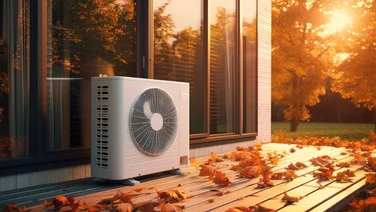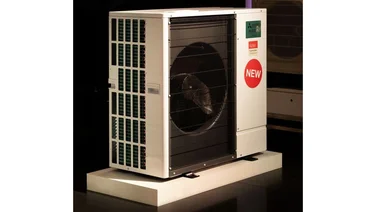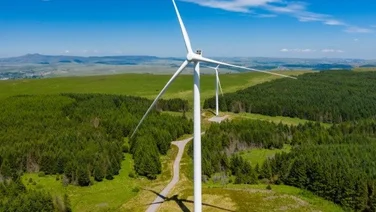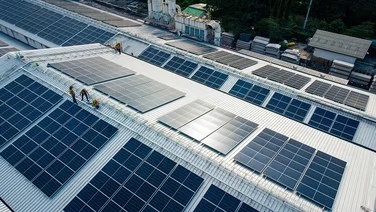- What are renewable energy sources?
- 1. Install solar panels
- 2. Install a heat pump
- 3. Get a domestic wind turbine
- 4. Install solar thermal panels
- 4. Use biomass to heat your home
- 5. Make your own biofuel
- 6. Generate power from a nearby water source
- 8. Install your own Micro-CHP power plant
- The financial benefits of renewable energy
- Renewable energy at home saves money on monthly bills
- Take advantage of stable and predictable energy costs for the future
- Government grants can help with the upfront costs
- Futureproofing with renewables adds value to your home
- Renewables are in investment, not a cost

A UK home with solar panels and a wind turbine installed – credit?
Renewable energy refers to energy sources that are naturally replenished and can be harnessed to produce energy, usually electricity. Examples of renewable energy for your home include solar panels that capture sunlight, or wind turbines that use the wind to generate electricity.
These sources offer a sustainable substitute for fossil fuels, reducing our reliance on the grid, carbon emissions and promoting environmental sustainability.
Implementing renewable energy in households reduces electricity bills and contributes to energy self-sufficiency and a healthier environment with fewer green house gas (GHG) emissions.
What are renewable energy sources?
Renewable energy sources are sources that are naturally replenished at a higher rate than they are consumed. Different types include solar energy, wind power, hydroelectric power and geothermal energy.
So, what are the main reasons people use renewable energy sources? According to the 2024 National Home Energy Survey, 51% of people would be influenced to use renewable energy due to saving money on energy bills, followed by Government incentives at 18%.
Millennials are most influenced by energy bills, with 57% claiming it is a primary influence when using renewable energy sources. Only 43% of Boomers agreed.
As a demographic, Boomers also had the largest percentage of people who wouldn’t consider using renewable energy sources in their homes, regardless of factors, at 10%. However, the younger the generation, the more open to renewable energy they seem to be, with only 4% of Gen Z unwilling to use renewable energy.
National Home Energy Survey 2024
Read the full findings from this year’s report by downloading the PDF here.
Here are eight ways in which you can incorporate renewable energy into your home.
1. Install solar panels

Solar panels being installed on a roof – credit: rawpixel
We are sure you are more than familiar with the concept of solar panels. You don’t get much more ‘renewable’ than harnessing the power of the Sun to generate your own electricity.
Using the photovoltaic effect, you can convert sunlight into usable electricity by installing solar panels on your home. This electricity can then be used to directly power your home electronics, and even heat your home.
Solar panels generate power during daylight hours and do not require sunny conditions to function. However, they do generate more electricity on sunnier days.
If you really want to power up your renewable energy home, the energy created during the day can be stored in batteries, allowing for electricity usage after the Sun has set. You can also make a pretty penny by selling back excess energy to the national grid under incentives like the government’s Smart Export Guarantee (SEG).
Another great thing about solar panels is that they reduce your reliance on the national grid, and therefore reduce your electricity bill from the day they are installed.
The savings made vary (obviously), but typically you can expect to save hundreds of pounds annually.
If you can afford the upfront costs, solar panels are a no-brainer and will pay back your investment in between 10-15 years- depending on the size of your installation.
Use our quick quote form to get a quote from a trusted solar panel installer today.
2. Install a heat pump

Replacing a gas boiler with a heat pump will reduce the carbon footprint of your home by up to 70% – pic credit AIRA
Like a fridge, but in reverse, a heat pump is an electrical appliance that transfers heat from the environment outside, and pumps it into the air conditioning, hot water or central heating system inside a building.
Rather than using a fossil fuels to heat water, a heat pump uses heat that has already been generated by solar energy, and uses electricity to pump that heat into our homes and hot water systems.
Heat pumps extract heat from their surroundings. That can be from the air, the ground or a water source outside. This is then used to heat a refrigerant liquid in the heat pump that turns the refrigerant into gas. The gas is then pumped into a compressor, which causes its temperature to rise. The heated gas is then passed over a heat exchange surface from where it can be blown around your home, or transferred into a central heating or hot water system.
A heat pump is an incredibly energy efficient way to heat a building. Installing a heat pump will reduce the carbon footprint of your home by up to 70%.
Owing to the different ways in which they extract heat from their environment, there are various types of heat pump, including air-source heat pumps (ASHP), ground-source heat pumps (GSHP), water-source heat pumps (GSHP) and air-to-air heat pumps.
As the transition from a gas boiler to a heat pump is expensive, the UK government is currently offering £7500 as a grant towards to the installation costs of a heat pump, through the Boiler Upgrade Scheme.
For a free quote from a trusted heat pump installer, fill out our simple form.
3. Get a domestic wind turbine

Colourful wind turbines – credit: Flower Turbines
The United Kingdom is one of the windiest countries on Earth. For this reason, it makes sense to use that free energy for your benefit rather than complain about the weather.
To do this, you’ll need your own private wind turbine.
We are not talking about the enormous ones that you see on wind farms here, but smaller domestic wind turbines that can be installed on your roof, or freestanding within the grounds around your home.
The electricity is generated by the wind turning the blades of the domestic wind turbine, which drives the internal turbine to create power. An estimated 6kW pole-mounted turbine could save you around £340 a year on electricity bills and earn about £235 per year in Smart Export Guarantee (SEG) payments.
4. Install solar thermal panels

Solar thermal panels
Solar panels are not the only way to harness the sun’s power and save money. Another type of solar panel is solar water heating panels, or solar thermal systems, which can help reduce hot water costs at home.
Solar water heating systems use panels installed on your roof, mounted on a freestanding frame, or even affixed to a wall. They harness solar energy to warm water for storage in a hot water cylinder or thermal store.
While they will reduce your energy demand from the grid, it is unlikely that you would be able to provide enough water for a central heating system using solar thermal panels. Therefore you will still need to have a back up to ensure that your home is warm all year round.
4. Use biomass to heat your home

Biomass heating systems burn organic materials like wood pellets, chips or logs – pic credit: Wikimedia Commons
It may seem counterintuitive, but technically speaking, burning fuel made by nature is also a form of renewable energy generation. Called biomass, this is a callback to our ancestral past of burning things like wood but with a new twist.
Biomass heating systems utilize organic materials like wood pellets, chips, or logs to generate heat and hot water. This method of heating has lower carbon emissions compared to fossil fuels such as coal and oil, as the wood burned in these systems only releases as much carbon as the tree absorbed while it was growing.
It is, in effect, net zero in terms of carbon emissions.
Furthermore, it is estimated that a biomass system can save up to £1,100 per year compared to an old electric heating system.
Biomass plants can also supply businesses with a renewable energy source, enabling them to decrease their carbon emissions and make a substantial contribution to the UK’s future heat and energy generation needs.
A biodigester producing biogas in a garden
5. Make your own biofuel

As an extension of point 4 above, you can take the concept one step further by making your own biofuel at home.
Technically called biodigesters, this is a relatively new form of renewable energy system for the home.
The basic idea is to feed the digester with scraps of food, grass cuttings, or garden waste, and let a colony of bacteria do their thing. The microbes will break down the organic material inside the digester to make methane stored inside the digester ready for use.
The digester can then cook food through your gas stove, burning it like natural gas. As a bonus, the digester also gives you rich fertilizer that you can use to grow plants.
The market leader in this field is HomeBiogas, but others are available.
Other options include making woodchips or briquettes that can be used as feedstock for your biomass boiler (if you have one).
6. Generate power from a nearby water source

Diversion canal of an old mill which has become a micro hydroelectric power station in Provence, France
If you are lucky enough to live near a free-flowing water source, like a stream or river, then micro-hydroelectric systems are another nice way to generate your own electricity. These systems use the power of moving water to generate electricity that you can use in your home.
All rivers and streams flow downhill. They possess potential energy due to their height before descending the hill.
Hydropower systems convert potential energy into kinetic energy in a turbine, driving a generator to produce electricity. More height and water flow mean more electricity generated.
The generation of electricity from a system also relies on its efficiency in converting the power of moving water into electrical power.
8. Install your own Micro-CHP power plant
Finally, another way to become part of the renewable energy revolution is to use micro combined heat and power, or micro-CHP for short.
Micro-CHP is a technology that produces heat and electricity simultaneously in individual homes or buildings, using the same energy source.
The primary output of a micro-CHP system is heat, with some electricity generation, typically at a ratio of about 6:1 (heat to electricity) for domestic appliances.
Once warmed up, a typical residential system can generate up to 1 kW of electricity. The total electricity produced over a year depends on the system’s operational hours.
Domestic micro-CHP systems are typically fueled by mains gas or liquified petroleum gas (LPG). However, some models can be powered by oil or bio-liquids, such as biodiesel, making them even more renewable.
Some, like those produced by Viessman, are increasingly powered by fuel cells, or batteries.
The financial benefits of renewable energy
As you’ve seen, renewable energy offers significant financial advantages for homeowners, making it an attractive alternative to traditional energy sources. Here are some key financial benefits:
- Lower energy bills: Homeowners have the opportunity to lower their monthly energy expenses by installing solar panels or small wind turbines. Solar power, in particular, has become the most cost-effective energy source worldwide, enabling homeowners to produce their own electricity at a much lower cost than traditional grid power.
- Stable and predictable costs: Renewable energy systems offer homeowners stable and consistent energy costs, unlike fossil fuels, which are susceptible to price fluctuations. This predictability makes it easier for homeowners to manage their budgets.
- Long-term savings: The initial investment in renewable energy systems can be offset by long-term savings. Over time, the reduction in monthly energy expenses can lead to substantial financial savings. For example, a solar PV system can pay for itself within a few years and continue to provide free electricity thereafter.
- Increased home value: Homes with renewable energy systems often increase property value. Buyers pay more for lower utility costs and reduced environmental impact.
- Incentives and rebates: The UK government and local authorities provide incentives, tax credits, grants, and rebates to homeowners who install renewable energy systems, which can significantly reduce upfront installation costs, making renewable energy more accessible.
Renewables are in investment, not a cost
“Renewable energy systems, whether the more traditional solar panels and wind turbines, or up-and-coming ones like micro-CHP, and fuel cells are a great way to cut your addiction to fossil fuels,” explains energy assessor Christopher McFadden.
“Saving the planet aside, in a world that is becoming increasingly more unstable, it is more important than ever to become as energy independent as possible,” he added.
“You’ll also help the national economy through supporting employment and reducing the nation’s exposure to unreliable third parties who supply our country with imported fossil fuels.”
“You should think of it like investing. You are probably well on top of your savings and investments (either private or through your employment), so why not extend the thinking to heating and powering your home,” Chris added.
“If it saves you money now and in the future, stops you from worrying about rising energy costs, and adds value to your home, that can’t be a bad thing, can it?” Chris concluded






